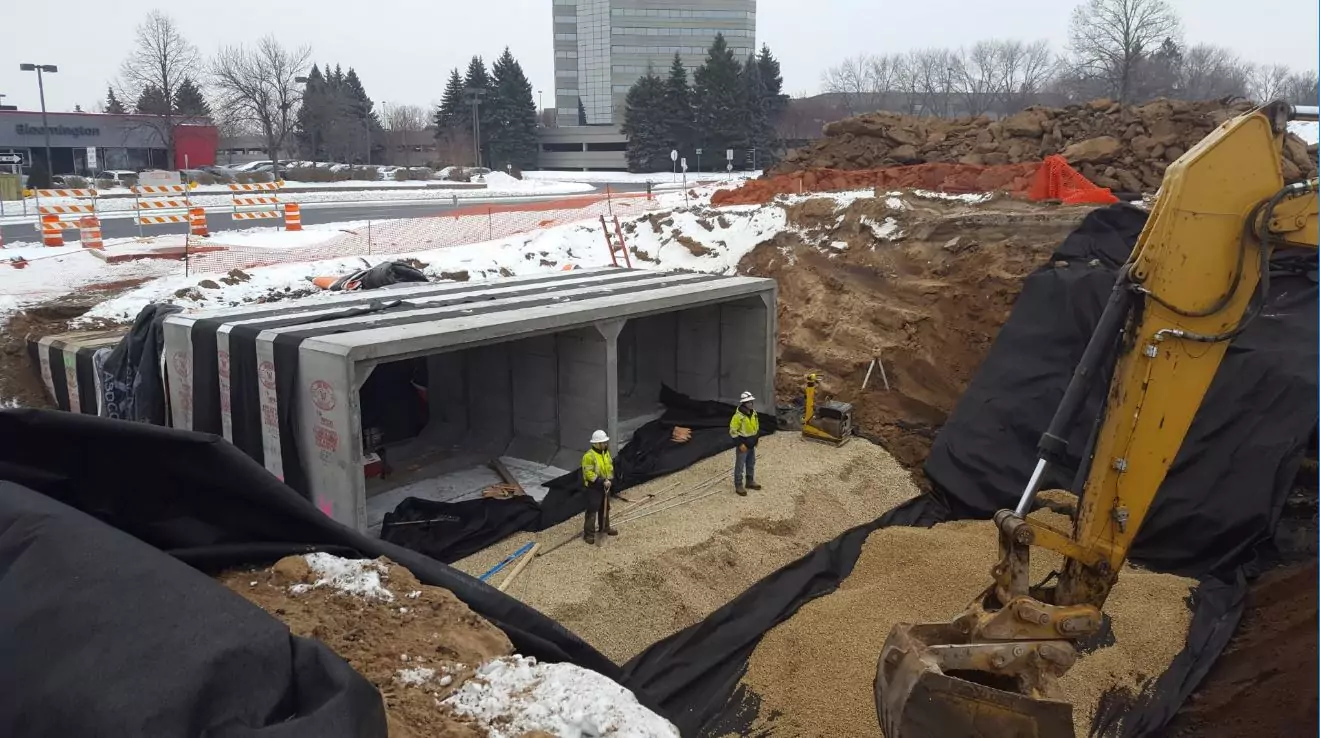
Paved Wetlands – Retrofitting Flood Storage in a Built Environment
The City of Bloomington has struggled with flooding at the Knox Avenue and American Boulevard intersection for many years. Prior to any development of Bloomington, the intersection was home to a wetland complex that managed stormwater runoff. As the community developed, the expanding impervious surface area replaced the wetlands and low areas became landlocked basins, leaving residents and businesses with severe flooding problems. Water consistently pooled over three feet deep, requiring emergency services to close the road to prevent safety hazards.
An unexpected sustainable solution despite project challenges
To provide a workable solution, Bolton & Menk designed a subsurface linear stormwater storage system that provided the necessary conveyance to route stormwater away from the problem area. This eliminated the need for large property acquisition to construct stormwater ponds, while providing the necessary flooding relief and maintaining the downstream lake levels of Upper Penn Lake. The project faced numerous challenges including contaminated groundwater, muck soils in historic wetlands, existing large PCCP watermain, and securing large easements on commercial properties to facilitate construction. The linear stormwater detention solution was designed to reduce localized flooding on Knox Avenue by providing 12.5 acre-feet of stormwater storage which connects to the Penn Avenue storm sewer almost 2,000 ft downstream and slowly releasing the flow into the system.
Water Quality – An Added Bonus
This project met the needs of the city’s Municipal Separate Storm Sewer System (MS4) and construction permits by providing significant water quality improvement to the area. The design consists of 750 ft of double cell box culvert and 2,000 feet of 144-inch CMP pipe. The first 40 feet of box culvert was sumped to collect large sediments and debris prior to entering the north cell. The north cell acts as an “isolator row” where all runoff is routed to, it then ponds, up to three feet deep, before overflowing to the south cell. The three feet of water in the north cell infiltrates the ground through the joints of the box culvert and provides a water quality volume benefit equal to 1-inch over the City right of way draining to the system. The linear stormwater system not only allows this project to mitigate flooding, it also provides a significant water quality benefit to City and Upper Penn Lake.
“Sustainability in our projects should have the utmost priority to ensure we provide a world to future generations that is better than the one we currently enjoy.” said Josh Stier, senior transportation project engineer.
City Redevelopment Continues
Development practices in the 1960’s regularly disregarded the long-term implications of increasing impervious surface without providing flood storage to accommodate the increased runoff during rainfall events. Since the area was fully developed, the project team had to retrofit a sustainable solution that didn’t simply “push the problems downstream.” The resulting subsurface linear stormwater storage system is a substantial improvement for adjacent property owners and has significantly reduced flooding impacts for large rain events. Upon completion of the project in early 2019, area redevelopment activity was immediately initiated for the construction of nearly 250 workforce housing units. These units will further the City’s vision for the Penn-American District as a high-density, pedestrian-friendly, and transit-oriented development. Since completion, the city is happy to report no flooding incidents have occurred.


